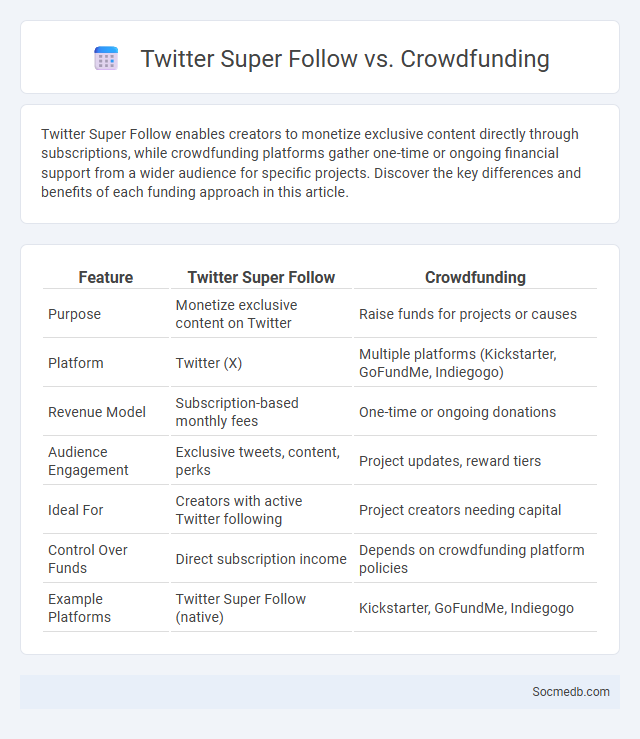
Photo illustration: Twitter Super Follow vs Crowdfunding
Twitter Super Follow enables creators to monetize exclusive content directly through subscriptions, while crowdfunding platforms gather one-time or ongoing financial support from a wider audience for specific projects. Discover the key differences and benefits of each funding approach in this article.
Table of Comparison
| Feature | Twitter Super Follow | Crowdfunding |
|---|---|---|
| Purpose | Monetize exclusive content on Twitter | Raise funds for projects or causes |
| Platform | Twitter (X) | Multiple platforms (Kickstarter, GoFundMe, Indiegogo) |
| Revenue Model | Subscription-based monthly fees | One-time or ongoing donations |
| Audience Engagement | Exclusive tweets, content, perks | Project updates, reward tiers |
| Ideal For | Creators with active Twitter following | Project creators needing capital |
| Control Over Funds | Direct subscription income | Depends on crowdfunding platform policies |
| Example Platforms | Twitter Super Follow (native) | Kickstarter, GoFundMe, Indiegogo |
Introduction to Twitter Super Follow and Crowdfunding
Twitter Super Follow enables creators to monetize content by offering exclusive posts, community access, and perks directly to subscribers. Crowdfunding on social media platforms harnesses the power of your network to raise funds for projects, causes, or startups through small contributions from numerous supporters. Leveraging Twitter Super Follow alongside crowdfunding can amplify your reach and generate sustained financial support efficiently.
What is Twitter Super Follow?
Twitter Super Follow is a subscription feature that allows creators to offer exclusive content and perks to followers for a monthly fee. Subscribers gain access to bonus tweets, newsletters, and community interactions that are not available to regular followers. This monetization tool helps creators build deeper connections and generate revenue directly from their engaged audience.
Understanding Crowdfunding for Creators
Understanding crowdfunding is essential for creators aiming to leverage social media platforms to finance their projects and engage their audience. You can maximize your campaign's success by optimizing your social media presence, targeting the right communities, and sharing compelling content that highlights your creative vision. An effective crowdfunding strategy on platforms such as Kickstarter, Indiegogo, or Patreon relies on clear communication, consistent updates, and authentic storytelling to build trust and motivate backers.
Key Features Comparison: Super Follow vs Crowdfunding
Super Follow enables content creators to monetize exclusive posts and subscriber-only content directly on platforms like Twitter, offering a seamless user experience with integrated payment processing. Crowdfunding platforms such as Kickstarter and Indiegogo support project-based fundraising by allowing a broad community to contribute financially toward specific goals, often with tiered rewards and deadlines. To maximize Your social media monetization strategy, consider Super Follow for ongoing supporter engagement and crowdfunding for ambitious, one-time projects requiring larger financial backing.
Monetization Potential: Which Offers More Value?
Social media platforms like YouTube and Instagram offer significant monetization potential through diverse revenue streams such as ads, sponsorships, and affiliate marketing. YouTube's robust ad revenue system and long-form content monetization generally provide higher income opportunities, while Instagram excels in influencer marketing and brand partnerships due to its visual engagement. Understanding your audience and content style is essential to maximizing your monetization value on these platforms.
Engagement and Community Building Differences
Engagement on social media refers to measurable interactions such as likes, comments, shares, and clicks that indicate user activity and interest in specific content. Community building involves creating a loyal group of followers who actively participate, collaborate, and support each other around shared interests, fostering long-term relationships and brand loyalty. While engagement is often short-term and content-focused, community building emphasizes ongoing connections and deeper emotional investment among members.
Content Control and Flexibility
Social media platforms offer advanced content control features, enabling users to customize privacy settings, filter comments, and moderate posts to maintain a safe and engaging environment. Flexibility in scheduling tools and multimedia content formats allows businesses and influencers to optimize audience reach and engagement effectively. These capabilities enhance user experience by balancing creative freedom with responsible content management.
Fees and Revenue Share Breakdown
Social media platforms generate significant revenue through advertising fees, subscription services, and transaction commissions, with major players like Facebook, Instagram, and YouTube earning billions annually. The revenue share breakdown often involves the platform retaining 20-45% of transaction fees from content creators, app developers, and advertisers, while distributing the remainder to users or partners. Understanding these fees helps you optimize your earnings and strategically engage with social media monetization opportunities.
Pros and Cons of Each Approach
Social media platforms like Facebook, Instagram, and Twitter offer unique advantages and drawbacks depending on your goals. Facebook excels in building community and detailed targeting but can suffer from privacy concerns and algorithm changes affecting reach. Instagram provides high engagement through visual content but often requires consistent, high-quality posts to maintain follower interest, while Twitter is ideal for real-time updates and trending topics but limits message length and can experience rapid content turnover.
Choosing the Best Platform for Your Creator Journey
Selecting the ideal social media platform is crucial for maximizing your reach and engagement as a creator. Consider each platform's audience demographics, content format preferences, and algorithmic strengths to ensure your content resonates effectively. Tailoring your strategy to platforms like Instagram, YouTube, or TikTok can significantly elevate your visibility and growth in your creator journey.
 socmedb.com
socmedb.com